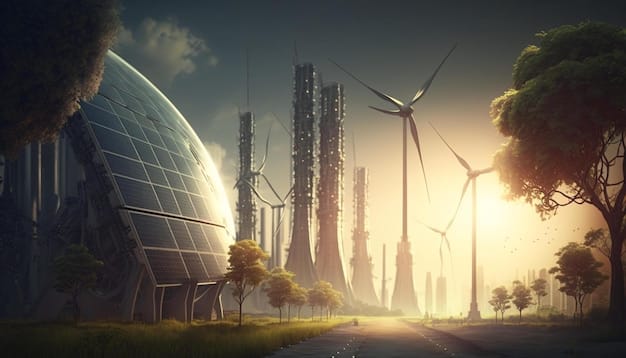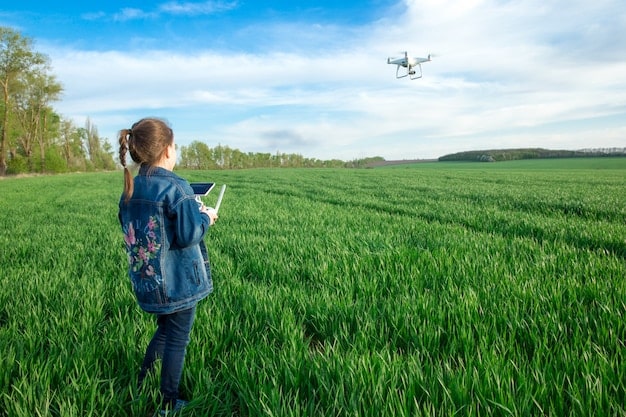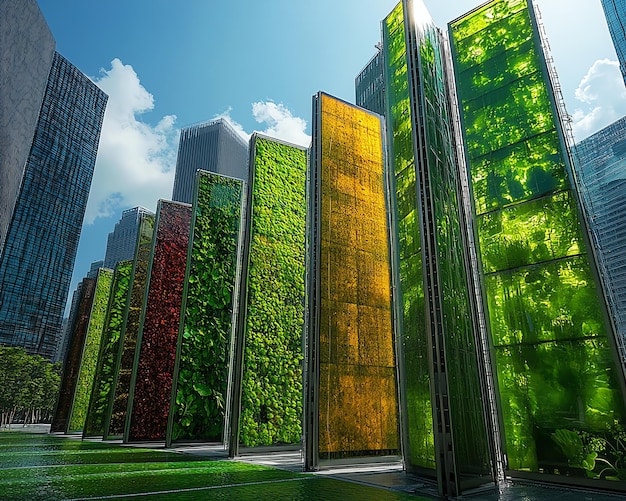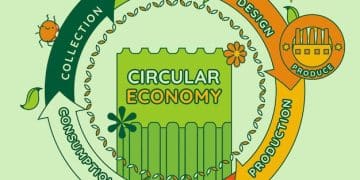Tech’s Role in US Sustainability & Conservation Efforts

Technology acts as a pivotal force, driving sustainable practices and environmental conservation efforts across the United States through innovative solutions, data-driven insights, and enhanced public engagement.
The intricate relationship between innovation and ecological preservation is more critical than ever. In the United States, pinpointing the role of technology in promoting sustainable practices and environmental conservation in the US reveals a profound shift in how we approach environmental stewardship. This exploration delves into the ways advanced technological solutions are not merely supporting, but actively catalyzing a movement towards a more sustainable and resilient future.
Precision Agriculture and Smart Farming Technologies
Precision agriculture represents a significant leap in sustainable farming, leveraging technology to optimize crop yields while minimizing resource consumption and environmental impact. This approach moves beyond traditional farming methods, embracing data-driven decision-making to enhance efficiency and reduce waste.
Optimizing Resource Use
One of the primary benefits of precision agriculture is its ability to fine-tune inputs. Technologies such as GPS-guided tractors and drones map fields with incredible accuracy, allowing farmers to apply water, fertilizers, and pesticides only where and when needed. This targeted application significantly reduces chemical runoff into waterways and lowers greenhouse gas emissions associated with excessive fertilizer use.
- Reduced water consumption through smart irrigation systems.
- Minimized chemical inputs via variable-rate application technology.
- Enhanced soil health monitoring for sustainable land management.
Furthermore, sensor networks provide real-time data on soil moisture, nutrient levels, and crop health, enabling immediate adjustments. This proactive management prevents potential environmental damage and ensures more efficient use of valuable resources, contributing substantially to conservation efforts.

Data-Driven Crop Management
The integration of artificial intelligence (AI) and machine learning (ML) further elevates precision agriculture. These technologies analyze vast datasets, from historical yield information to satellite imagery and weather patterns, to predict optimal planting times, identify disease outbreaks early, and forecast yields with greater accuracy.
This predictive power allows farmers to make more informed decisions, reducing the need for broad-spectrum interventions and fostering a more harmonious relationship between agricultural practices and ecological health. The shift towards data-driven farming illustrates a fundamental change in how food is produced, prioritizing sustainability alongside productivity.
In essence, precision agriculture technologies are transforming farming into a highly efficient, environmentally conscious process. By using resources more precisely, these innovations are crucial for both agricultural sustainability and broader environmental conservation, showcasing how focused technological application can yield widespread ecological benefits.
Renewable Energy and Smart Grid Systems
The transition to renewable energy sources is paramount for combating climate change and reducing carbon footprints. Technology plays an indispensable role in accelerating this transition, from advanced solar and wind energy systems to the intelligent grids that manage their distribution.
Advancements in Renewable Energy
Significant technological breakthroughs have made solar and wind power more efficient and cost-effective than ever before. Innovations in photovoltaic cell design have dramatically increased solar panel efficiency, while larger, more aerodynamically advanced wind turbines capture more energy even at lower wind speeds. These enhancements make renewables increasingly competitive with traditional fossil fuels.
- Improved solar panel efficiency and durability.
- Larger and more efficient wind turbine designs.
- Development of energy storage solutions like advanced batteries.
Beyond generation, the development of sophisticated energy storage solutions, particularly advanced battery technologies, addresses the intermittency challenge of renewables. These batteries store excess energy during peak production times and release it when demand is high or generation is low, ensuring a stable and reliable energy supply.
The Role of Smart Grids
Smart grids are the brains behind a sustainable energy infrastructure. Utilizing digital communication technology, these grids monitor, control, and manage energy flow from all generation sources to consumers. They facilitate the integration of diverse renewable energy sources, optimize energy distribution, and enable demand-response programs.
By providing real-time data on energy consumption and availability, smart grids empower both utilities and consumers to make more informed decisions about energy use. This reduces waste, enhances grid resilience, and supports the widespread adoption of renewable energy by managing its inherent variability. The synergy between renewable energy generation and smart grid management illustrates a comprehensive technological approach to sustainable energy.
The evolution of renewable energy technologies coupled with the implementation of smart grids is fundamental to creating a decarbonized energy system. These technological contributions are not only diminishing reliance on fossil fuels but also constructing a more robust and sustainable energy landscape for the US.
Advanced Monitoring and Data Analytics for Conservation
Effective environmental conservation hinges on understanding the intricate dynamics of ecosystems. Advanced monitoring technologies, coupled with powerful data analytics, provide unprecedented capabilities for tracking environmental changes, identifying threats, and informing conservation strategies.
Remote Sensing and Satellite Technology
Satellite imagery and remote sensing technologies offer a bird’s-eye view of vast natural landscapes, enabling scientists and conservationists to monitor deforestation, track wildlife migrations, assess water quality, and detect changes in ice caps and glaciers over time. This global perspective is invaluable for understanding large-scale environmental trends and impacts.
From monitoring illegal logging in remote forests to tracking the health of coral reefs, these technologies provide critical data that would be impossible or prohibitively expensive to collect by conventional means. The ability to observe and analyze environmental indicators from space allows for timely interventions and more effective resource management.
IoT and Sensor Networks
On a more localized scale, the Internet of Things (IoT) and sensor networks deploy small, interconnected devices to collect real-time data on specific environmental parameters. These sensors can monitor air pollution levels, water flow in rivers, soil contamination, and even animal movements in protected areas. This granular data offers immediate insights into local environmental conditions.
- Real-time air and water quality monitoring.
- Early detection of environmental hazards.
- Tracking wildlife and habitat conditions.
The continuous flow of data from these networks enables rapid response to environmental incidents and supports adaptive management strategies. For instance, sensors can alert authorities to critical changes in water levels that might indicate a flood risk or detect pollutants entering a water body, allowing for swift action to mitigate damage.
Big Data and Predictive Analytics
The massive amounts of data collected through remote sensing, IoT devices, and other sources are then processed and analyzed using sophisticated big data and predictive analytics tools. These tools can identify patterns, forecast future environmental conditions, and simulate the potential impacts of various conservation interventions. This analytical power transforms raw data into actionable intelligence.
Predictive models can help conservationists anticipate the spread of invasive species, forecast the impacts of climate change on specific habitats, or optimize the deployment of resources for restoration projects. By understanding potential future scenarios, conservation efforts can be more proactive and impactful, preserving biodiversity and natural resources more effectively.
The confluence of advanced monitoring and data analytics provides a robust framework for environmental conservation in the US. These technologies offer the essential data and insights needed to navigate complex ecological challenges and to implement informed, strategic conservation initiatives that protect our planet’s invaluable natural heritage.
Sustainable Urban Development and Green Building Practices
As urbanization continues, the focus shifts towards creating cities that are not only livable but also environmentally sustainable. Technology is a key enabler of this transformation, driving innovations in urban planning, infrastructure, and building design to minimize ecological footprints.
Smart City Initiatives
Smart city concepts integrate advanced technologies to improve urban efficiency and sustainability. This includes intelligent transportation systems that reduce traffic congestion and emissions, smart waste management systems that optimize collection routes and promote recycling, and smart lighting systems that conserve energy.
By leveraging data and connectivity, smart cities aim to create environments that are more resource-efficient, reduce pollution, and enhance the quality of life for residents. The implementation of sensor networks and data analytics allows urban planners to make data-driven decisions that lead to greener and more resilient urban centers.
Green Building Technologies
Green building practices incorporate design, construction, and operation methods that are environmentally responsible and resource-efficient throughout a building’s life cycle. Technology facilitates this through innovative materials, energy-efficient systems, and smart building management.
- Use of recycled and sustainable building materials.
- Implementation of energy-efficient HVAC and lighting systems.
- Integration of renewable energy sources in building design.
For example, advanced insulation materials reduce energy consumption for heating and cooling, while smart thermostats and building automation systems optimize energy use based on occupancy and external conditions. Solar panels integrated into building roofs or facades provide renewable energy, further reducing reliance on fossil fuels.

Sustainable Infrastructure Development
Beyond individual buildings, technology influences the development of sustainable urban infrastructure. This includes permeable pavements that reduce stormwater runoff and replenish groundwater, green roofs that mitigate the urban heat island effect and improve air quality, and advanced water treatment facilities that ensure clean water supply and efficient wastewater management.
The planning and implementation of these infrastructures often rely on sophisticated modeling and simulation tools to predict their environmental performance and optimize their design. These technological approaches ensure that urban growth contributes positively to environmental conservation rather than detracting from it, fostering healthier and more sustainable communities.
In essence, technology is enabling a paradigm shift in how cities are built and managed. By integrating smart solutions and green building practices, urban areas can significantly reduce their environmental impact, becoming models of sustainability and contributing substantially to environmental conservation efforts in the US.
Waste Management and Circular Economy Solutions
The challenge of waste management is immense, but technological innovations are offering new pathways towards a circular economy—a system where resources are kept in use for as long as possible, extracting the maximum value from them whilst in use, then recovering and regenerating products and materials at the end of each service life.
Advanced Recycling Technologies
Traditional recycling methods often face limitations in processing diverse waste streams. However, advanced recycling technologies, such as chemical recycling of plastics and more efficient sorting systems, are expanding the range of materials that can be effectively recycled. These innovations transform waste into valuable resources, reducing the need for virgin materials and minimizing landfill waste.
For instance, sophisticated optical sorters and robotic systems can now identify and separate different types of plastics and other materials with much greater precision, significantly improving the quality and quantity of recycled outputs. This technological progress is vital for closing material loops and reducing pollution.
Waste-to-Energy Conversion
While recycling is preferred, some waste inevitably remains. Waste-to-energy (WtE) technologies convert non-recyclable waste into usable forms of energy, such as electricity or heat. Modern WtE plants employ advanced combustion and gasification processes that are designed to minimize emissions and maximize energy recovery, offering a more sustainable alternative to landfilling.
- Increased efficiency in waste sorting and material recovery.
- Reduced landfill waste through enhanced recycling and WtE.
- Creation of valuable feedstock from previously non-recyclable waste.
These facilities not only reduce the volume of waste destined for landfills but also contribute to the energy supply, thereby decreasing reliance on fossil fuels. Continuous technological improvements in emission control also ensure that WtE processes are environmentally responsible.
Circular Economy Platforms and Traceability
Digital platforms and blockchain technology are emerging as powerful tools for facilitating a circular economy. These technologies can track materials throughout their lifecycle, from production to consumption and recycling, enabling greater transparency and accountability. This traceability ensures that products and components can be easily recovered and reused or recycled.
By connecting producers, consumers, and recyclers, these platforms optimize resource flows and create new business models based on reuse and repair. For example, platforms supporting product-as-a-service models encourage manufacturers to design durable, repairable products, as they retain ownership and responsibility for the product’s end-of-life.
The intersection of technology with waste management is paving the way for a truly circular economy. By enhancing recycling, leveraging waste for energy, and establishing robust traceability systems, technology is instrumental in transforming waste challenges into opportunities for resource conservation and sustainable living in the US.
Conservation Education and Public Engagement Through Digital Tools
Effective conservation relies heavily on public awareness, understanding, and participation. Digital tools and platforms are revolutionizing how environmental education is delivered and how the public engages with conservation efforts, making information more accessible and interactive.
Interactive Educational Platforms
Online platforms, virtual reality (VR) and augmented reality (AR) experiences, and educational apps are transforming environmental learning. These tools provide immersive and engaging ways for people of all ages to learn about ecosystems, biodiversity, climate change, and conservation challenges.
For instance, VR simulations can transport users to endangered habitats, allowing them to witness the impacts of human activity firsthand, while AR apps can overlay educational content onto real-world environments. This experiential learning fosters a deeper connection to nature and a greater understanding of conservation importance.
Citizen Science and Crowdsourcing
Digital technologies empower ordinary citizens to contribute directly to scientific research and conservation efforts through citizen science initiatives. Mobile apps and online platforms allow volunteers to collect and submit data on local wildlife sightings, pollution levels, or plant species, which scientists can then use for research and monitoring.
- Immersive learning experiences through VR/AR.
- Direct public participation in data collection for research.
- Wider reach for conservation messages via social media.
This crowdsourcing of data not only expands the geographical and temporal scope of environmental monitoring but also actively engages the public in the scientific process, fostering a sense of ownership and responsibility towards environmental conservation.
Social Media and Digital Advocacy
Social media platforms have become powerful tools for raising awareness about environmental issues, mobilizing support for conservation campaigns, and facilitating advocacy. Environmental organizations and activists use these platforms to share urgent information, promote sustainable practices, and coordinate collective action.
The ability to share compelling stories, images, and videos quickly and widely enables conservation messages to reach vast audiences, inspiring behavioral changes and influencing policy decisions. Digital advocacy campaigns can rapidly gather momentum, putting pressure on decision-makers and fostering a collective commitment to environmental protection.
Ultimately, technology is making conservation more inclusive, accessible, and impactful. By leveraging digital tools for education and engagement, the environmental movement can build a broader base of support, ensuring that conservation efforts are not just the domain of experts but a collective endeavor driven by an informed and engaged public across the US.
Policy and Regulatory Technologies for Environmental Governance
Effective environmental governance hinges on robust policy implementation, monitoring, and enforcement. Technology is increasingly being deployed to enhance these processes, ensuring compliance with environmental regulations and promoting more sustainable practices at a systemic level.
Regulatory Compliance and Reporting Tools
Digital platforms and software solutions are streamlining environmental compliance for businesses and industries. These tools automate the tracking of emissions, waste generation, and resource consumption, ensuring accurate reporting to regulatory bodies and helping organizations meet their environmental obligations more efficiently.
By providing real-time data and alerts regarding potential non-compliance, these systems enable companies to proactively address issues, reduce their environmental impact, and avoid penalties. This digitalization of compliance processes enhances transparency and accountability within the industrial sector.
Environmental Impact Assessment (EIA) Software
Sophisticated software and geospatial analysis tools are transforming Environmental Impact Assessments (EIAs). These technologies allow for more comprehensive and accurate evaluations of the potential environmental consequences of proposed projects, aiding decision-makers in formulating sustainable development plans.
- Automated environmental data collection and reporting.
- Enhanced capabilities for environmental impact assessments.
- Improved enforcement of environmental laws through digital monitoring.
By simulating various scenarios and analyzing vast amounts of environmental data, these tools can identify potential risks and mitigation strategies before projects commence, thereby preventing long-term ecological damage and promoting environmentally responsible development.
Blockchain for Environmental Traceability and Carbon Accounting
Blockchain technology offers a new paradigm for environmental governance by providing immutable and transparent records. It can be used to trace the origin of products to ensure they are sustainably sourced, track carbon emissions across supply chains, and verify compliance with environmental standards.
For example, blockchain can underpin carbon credit markets, ensuring the legitimacy and transparency of carbon reduction initiatives. This enhanced traceability and accountability can combat greenwashing and build greater trust in environmental claims, pushing industries towards genuinely sustainable practices.
The integration of technology into policy and regulatory frameworks is strengthening environmental governance in the US. These tools are not only making compliance easier but also enabling more informed decision-making and fostering greater accountability across all sectors, ultimately bolstering the nation’s commitment to environmental protection and sustainable development.
| Key Area | Brief Description |
|---|---|
| 🌱 Precision Agriculture | Optimizes farming inputs like water and fertilizer, reducing waste and environmental impact through data-driven methods. |
| ☀️ Renewable Energy | Advances in solar and wind power, coupled with smart grids, enhance efficiency and integration of clean energy. |
| 📊 Data Analytics for Conservation | Utilizes remote sensing and IoT for real-time monitoring and predictive analysis, informing conservation strategies. |
| ♻️ Circular Economy | Promotes advanced recycling and waste-to-energy solutions, reducing landfill waste and fostering resource efficiency. |
Frequently Asked Questions about Tech and Environmental Conservation
Technology significantly reduces carbon emissions in the US by enhancing renewable energy generation, such as more efficient solar panels and wind turbines. Smart grids optimize energy distribution, minimizing waste. Furthermore, innovations in electric vehicles and public transit infrastructure contribute to decreasing transportation emissions, while carbon capture technologies aim to remove CO2 directly from the atmosphere.
Smart cities like Boston and San Francisco are implementing technologies like intelligent transportation systems to reduce traffic and pollution, smart lighting to conserve energy, and sensor networks for efficient waste management. They also integrate green building technologies and sustainable infrastructure, promoting urban biodiversity and improving air and water quality. These initiatives collectively reduce the urban environmental footprint.
Absolutely. Individuals can contribute through citizen science apps that allow them to report environmental data, using smart home devices to optimize energy consumption, and adopting electric vehicles or e-bikes. Digital platforms also empower advocacy and support for conservation organizations, amplifying their impact. Every tech-enabled sustainable choice adds up to a greater collective effort.
AI plays a crucial role in analyzing vast environmental datasets from sensors and satellites, identifying patterns, and predicting future trends for proactive conservation. It optimizes resource allocation in precision agriculture, manages smart grids for energy efficiency, and develops predictive models for disaster prevention. AI also enhances robotic sorting in recycling, improving material recovery and waste management systems.
Technology addresses water scarcity through precision irrigation systems that deliver water directly to plant roots, minimizing evaporation and runoff. Advanced desalination technologies convert seawater into potable water, expanding supply sources. Additionally, smart water grids detect leaks and optimize distribution, while real-time monitoring sensors provide data on water levels and quality, enabling efficient resource management and conservation.
Conclusion
The journey towards a sustainable future in the United States is undeniably intertwined with technological advancement. From optimizing agricultural yields with precision farming to harnessing the power of renewable energy through smart grids, technology is proving to be an indispensable ally in the fight for environmental conservation. It empowers us with the tools to monitor, manage, and mitigate our impact on the planet, enhancing our understanding and fostering more mindful practices. As we look ahead, the continued innovation and strategic deployment of these technologies will be paramount in securing a greener, more resilient future for generations to come, truly cementing the role of technology in promoting sustainable practices and environmental conservation in the US.





